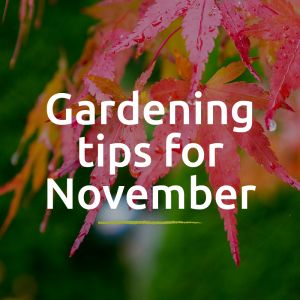Garden tips for November
Making the most of those short days
Whilst many welcome that extra hour in bed, it does mean an extra hour less in the garden as the nights start to draw in. The weather has been unusually mild for October, which means crops, lawns and flowers have continued to grow, but the pace will start to slow in the next few weeks as we see the return of ground frosts in preparation for the winter ahead.
Although the days may be short, the weather for this time of year is usually clear blue skies and sun accompanied by a crisp, cool air – perfect gardening weather!
There is still plenty to do, but we can also take the foot off the gas as many of the jobs over the next few months are general maintenance and prep for the upcoming season.
Wrapping up jobs in the flower garden
- Pots and containers will need some TLC over the colder months. Wrap large pots to prevent cracking when the frosts arrive.
- Move pots and containers with winter shrubs and flowers to positions that will shelter and protect them against the wind and winter weather.
- Less hardy plants will either need to be lifted and stored or wrapped with fleece to ensure they remain protected until spring.
- It’s not too late to plant those spring bulbs for early flowers.
- Plant out winter bedding plants.
- Continue to deadhead autumn flowers and remove yellowing leaves to prevent disease.
- Dig new flower beds and add a good soil conditioner such as 6x Natural Fibrous Plant Feed.
- Lift and store dahlia tubers if you’ve not already done so. How you overwinter dahlias will depend on weather conditions in your area. Take a look at our blog for more handy tips.
- Cut and divide! It is the ideal time to cut back ornamental grasses and divide perennials such as agapanthus and primrose.
- Make more of your plants by taking cuttings. Some plants are easier to take cuttings from than others, but take a look at our gardening tips to help as a guide.
- This time of year, houseplants really come into their own. Amaryllis, African corn lily and crocuses can all add fragrance and colour to your home. HighGround’s Indoor Bulb Planner is a fantastic planting and flowering guide for indoor plants.
- Take extra care of houseplants and ensure they are not placed next to heating to prevent plants drying out.
Winter crops in the growing garden
- Fruit trees and shrubs need extra protection in winter. Keep pesky insects from laying eggs and sheltering in crevices by using a winter tree wash and tree bands. For more gardening tips, take a look at the ‘Protect Trees in winter for summer success’ blog.
- Keep planting onion, garlic and shallot sets.
- Check summer harvests for any rotten crops and remove.
- Cover brassicas such as cabbage, kale and brussel sprouts to protect from birds.
- Stake large brassica stems to protect against wind and prevent breaking.
- Sow early varieties of peas and mangetout.
- Lettuces and herbs can continue to be grown indoors.
- Prune fruit trees and collect the last of the apples.
- Plant bare root fruit canes such as raspberries and currant varieties.
- Harvest any remaining root vegetables such as carrots and beetroot to protect against slugs and other hungry insects.
Pesky pests
- Keep an eye out for slugs in the greenhouse. The warm, damp conditions will see them gravitate to new shoots for a winter lunch. Check under pots, seed trays etc and remove.
- Some pests and diseases can overwinter, so be vigilant and check for mildew and eggs or larvae.
Lawns and hedges
- The weather has been mild and lawns will have continued to grow. Raise the lawn mower to a higher setting and give the lawn one last cut.
- Rake fallen leaves as they can block light and moisture.
- Lawns require little maintenance in the cooler months, so try not to walk on it once dormant.
- Plant bare root hedging, for tips see our guide.
General maintenance
- Rake, rake, rake and rake again! Fallen leaves that are free of disease are perfect for composting or using as a mulch.
- Birds and wildlife need extra care in the autumn and winter. Clean bird baths and feeders regularly with Vitax Greenhouse Disinfectant before replenishing with nuts and seeds.
- If you have clay soil, it is easier to work in autumn than when the frosts come. Use Vitax Clay Breaker to help improve drainage and give a good soil structure for spring planting.
- Tools and mowers can now be booked in for maintenance.
- Insulate greenhouses.
- Order those seed catalogues!
Shorter days means there is plenty of time to plan for next season. Sit back, relax and browse through those seed catalogues as now is the time for both you and your garden to take a well-deserved rest and replenish resources for the new season.
Your login details have been used by another user or machine. Login details can only be used once at any one time so you have therefore automatically been logged out. Please contact your sites administrator if you believe this other user or machine has unauthorised access.














